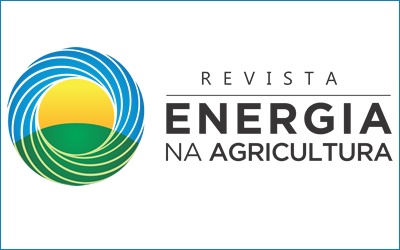CO-DIGESTÃO ANAERÓBIA DA FRAÇÃO ORGÂNICA DE RESÍDUOS SÓLIDOS URBANOS E DEJETOS DE BOVINO LEITEIRO: OBTENÇÃO E PROJEÇÃO DOS RESULTADOS EM UM ESTUDO DE CASO NO MUNICÍPIO DE PENÁPOLIS-SP
DOI:
https://doi.org/10.17224/EnergAgric.2022v37n1p1-8Resumo
CO-DIGESTÃO ANAERÓBIA DA FRAÇÃO ORGÂNICA DE RESÍDUOS SÓLIDOS URBANOS E DEJETOS DE BOVINO LEITEIRO: OBTENÇÃO E PROJEÇÃO DOS RESULTADOS EM UM ESTUDO DE CASO NO MUNICÍPIO DE PENÁPOLIS-SP
EDMAR CÉSAR GOMES DA SILVA1, JORGE DE LUCAS JÚNIOR2
1 Departamento de Energia na Agricultura, FCA/UNESP – Botucatu/SP – Brasil, Av. Universitária, 3780 - Altos do Paraíso, Departamento de Informática, IFSP – Birigui/SP - Brasil, Rua Pedro Cavalo 709, Portal da Pérola II, edmarsilva@ifsp.edu.br
2 Departamento de Energia na Agricultura, FCA/UNESP – Botucatu/SP – Brasil, Av. Universitária, 3780 - Altos do Paraíso, Departamento de Engenharia Rural, FCAV/UNESP – Jaboticabal/SP – Brasil, Via de Acesso Professor Paulo Donato Castellane S/N - Vila Industrial, jlucas@fcav.unesp.br
*Artigo extraído da tese do primeiro autor.
RESUMO: O trabalho objetivou analisar o potencial de produção de biogás e biofertilizante do processo de co-digestão anaeróbia do substrato composto pela fração orgânica dos resíduos sólidos urbanos (FORSU) e dejetos de gado bovino leiteiro (DGBL) utilizando biodigestores semicontínuos com capacidade de 60 L. Para análise dos dados considerou-se um delineamento inteiramente casualizado, utilizando-se o programa SAS® ao nível de significância de 5%. Foram analisadas a produção, o potencial de produção de biogás, a redução dos sólidos totais (ST), a redução de sólidos voláteis (SV) e os teores dos nutrientes Nitrogênio, Fósforo e Potássio (NPK) do biofertilizante. Os resultados foram aplicados em um estudo de caso tendo como base os dados de coleta de resíduos sólidos urbanos da cidade de Penápolis-SP co-digerido com estrume de 40 vacas. O experimento foi composto de 2 tratamentos, sendo um composto por 90% de FORSU, 10% DGBL e de água e outro tratamento de controle somente com DGBL e água, com 5 repetições para cada tratamento. Concluiu-se o biodigestor semicontínuo com uma proporção FORSU e DGBL de 90% -10%, produz 1 m3 de biogás com 36,23 kg de FORSU com um potencial de produção de biogás de 0,117 m3/kg de SV ad.
Palavras-chave: biogás, biofertilizante, energia renovável.
ANAEROBIC CO-DIGESTION OF THE ORGANIC FRACTION OF URBAN SOLID WASTE AND MILK CATTLE WASTE: OBTAINING AND PROJECTING RESULTS IN A CASE STUDY IN THE CITY OF PENÁPOLIS-SP
ABSTRACT: The objective of this study was to analyze the biogas and biofertilizer production potential of the anaerobic co-digestion process of the organic solid waste (FORSU) and dairy cattle manure substrate (DGBL) using semicontinuous biodigesters with capacity of 60 L. For data analysis we considered a completely randomized design, using the SAS® program at a significance level of 5%. The production, the biogas production potential, the reduction of total solids (TS), the reduction of volatile solids (VS) and the nutrient content Nitrogen, Phosphorus and Potassium (NPK) of the biofertilizer were analyzed. The results were applied in a case study based on data from the collection of urban solid waste from the city of Penápolis-SP co-digested with 40 cows manure. The experiment consisted of 2 treatments, one consisting of 90% FORSU, 10% DGBL and water and another control treatment with DGBL and water alone, with 5 replications for each treatment. The semicontinuous biodigester with a FORSU and DGBL ratio of 90% -10% was completed, producing 1 m3 of biogas with 36.23 kg of FORSU with a biogas production potential of 0.117 m3/kg of VS ad.
Keywords: biogas, biofertilizer, renewable energy
Publicado
Como Citar
Edição
Seção
Licença
Copyright (c) 2023 ENERGIA NA AGRICULTURA

Este trabalho está licenciado sob uma licença Creative Commons Attribution-NonCommercial-NoDerivatives 4.0 International License.
Esta revista proporciona acesso publico a todo seu conteúdo, seguindo o princípio que tornar gratuito o acesso a pesquisas gera um maior intercâmbio global de conhecimento. Tal acesso está associado a um crescimento da leitura e citação do trabalho de um autor. Para maiores informações sobre esta abordagem, visite Public Knowledge Project, projeto que desenvolveu este sistema para melhorar a qualidade acadêmica e pública da pesquisa, distribuindo o OJS assim como outros software de apoio ao sistema de publicação de acesso público a fontes acadêmicas.





